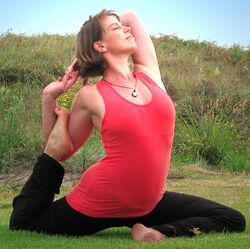Religion:Kapotasana
Kapotasana (Sanskrit: कपोतासन; IAST: Kapotāsana) or Pigeon Pose[1] is an asana.
Etymology
The name comes from the Sanskrit words kapota (कपोत) meaning "pigeon"[1] and asana (आसन) meaning "posture" or "seat".[2]
Description
A pose from the Ashtanga tradition is an advanced asana which resembles Chakrasana, or Wheel Pose. The shins and forearms are on the ground, the front body stretched upwards in the air. The pose is reached by going into a backbend with knees on the ground. It requires flexibility to bring the head back until it reaches the ground. Kapotasana is an asana which helps to open up the chest and also strengthens the back and groin. It opens and increases the flexibility of the hips[3], at the same time strengthening the back, and stretching the thighs and the groin. There is another pose sometimes referred to as pigeon pose, but is actually properly referred to as King Pigeon or Rajakapotasana They are two very different poses, and King Pigeon has different variations as well. One bent leg is out front, with the shin perpendicular, parallel to the front of the mat. The other leg is stretched out straight behind. The body is held upright and the back foot may be held in a hand, or in the crook of the elbow. The chest may also be folded over the front leg.
See also
- List of asanas
References
- ↑ 1.0 1.1 "Kapotasana A - AshtangaYoga.info". http://www.ashtangayoga.info/practice/asana-vinyasa-series/intermediate-series-nadi-shodhana/item/kapotasana-a/. Retrieved 2011-04-09.
- ↑ Sinha, S.C. (1 June 1996). Dictionary of Philosophy. Anmol Publications PVT. LTD.. p. 18. ISBN 978-81-7041-293-9. https://books.google.com/books?id=-zzRvh1fRzEC&pg=PA18. Retrieved 9 April 2011.
- ↑ "How To Pop Your Hip Or Crack Your Hip" (in en-US). https://www.women.com/laurawagner/lists/how-to-pop-hip.
Further reading
- Iyengar, B. K. S. (1 October 2005). Illustrated Light On Yoga. HarperCollins. ISBN 978-81-7223-606-9. https://books.google.com/books?id=pbx5AAAACAAJ. Retrieved 9 April 2011.
- Saraswati, Swami Satyananda (1 August 2003). Asana Pranayama Mudra Bandha. Nesma Books India. ISBN 978-81-86336-14-4. https://books.google.com/books?id=YpR1QgAACAAJ. Retrieved 9 April 2011.
- Saraswati, Swami Satyananda (January 2004). A Systematic Course in the Ancient Tantric Techniques of Yoga and Kriya. Nesma Books India. ISBN 978-81-85787-08-4. https://books.google.com/books?id=eWOrAAAACAAJ. Retrieved 9 April 2011.
External links




